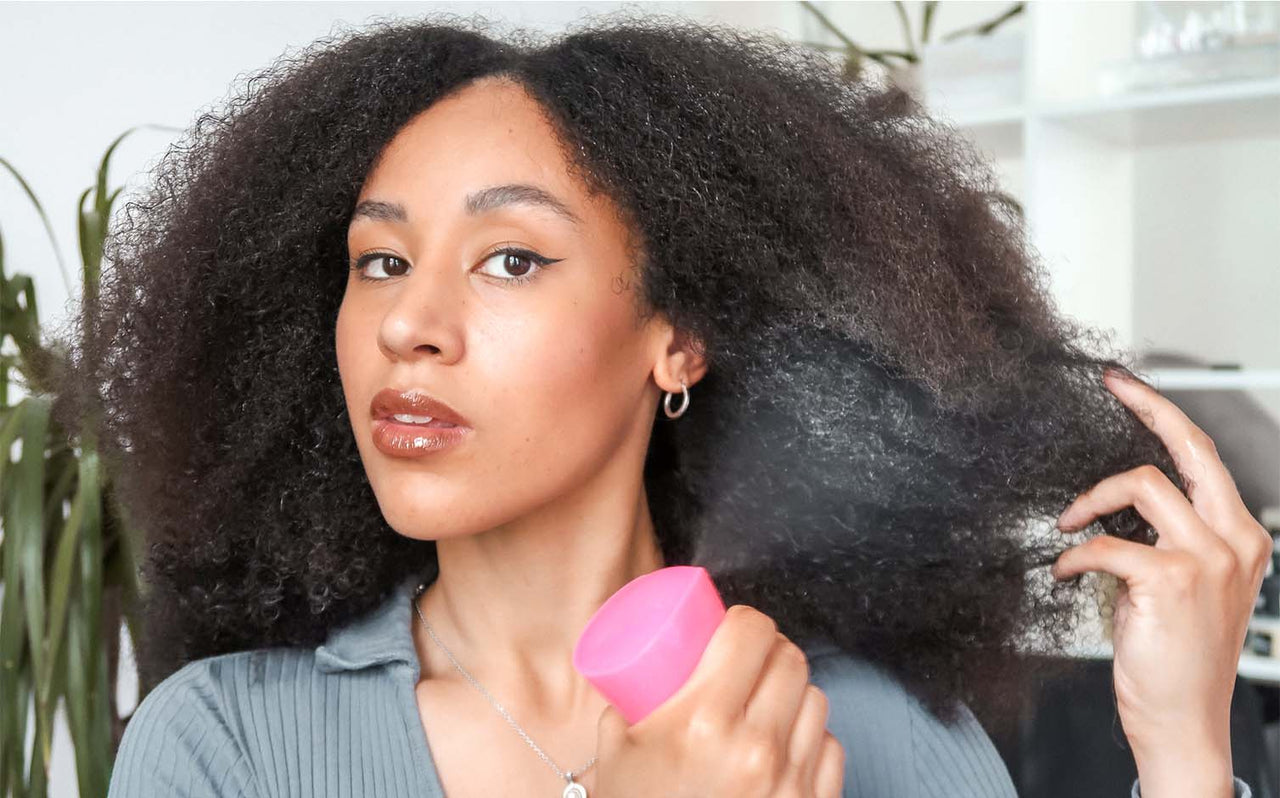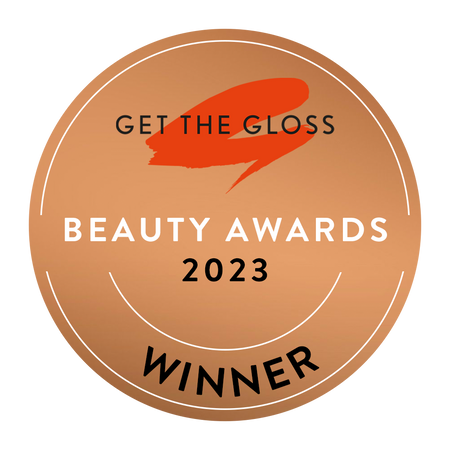We all dream of glossy, shiny locks that we often see on TV, but the real task is creating and maintaining them. Knowledge is key here because to keep hair moisturised hair, we need to understand what that means and how to work this into our daily routine. Stripping it back to basics, we know the two key factors for moisturised hair are hydration and, well, moisturiser! Hydration is pretty simple, and works two-fold, the more hydrated you keep yourself, the more it will shine through both your scalp and hair. Moisturising our hair is a little more complicated, where do we even start?

Before knowing how to improve your locks, you need to know why or how it became dry in the first place. Don’t fear, it is so common to have dry hair, but the relief is knowing it is temporary.
Our natural hair is often dry due to a lack of moisture. Often confused with oil, moisturising our hair with an actual hair moisturiser is crucial. Yes, that means stop using coconut oil on your scalp thinking it leads to moisturised hair, it doesn't.
Lack of moisturising dries out our hair, just like with our skin. Throw in the amount of heat we all use on our hair through hair dryers, straighteners, curling tongs, and it's like frying chicken in a pan with no oil - it will sizzle, stick and taste dry! Now, whilst we don’t want you to try tasting your hair, we do want you to understand why your hair might be dry and how to fix it.
There are other factors when thinking about curly hair, for some, the way in which the curls grow means it's more difficult for the scalp's natural oils to work their way down each hair strand. Though for others, their hair may be super moisturised at the roots but by the time they get to the end of each strand, it's dry again. This to an extent is unavoidable but you can certainly improve your routine to see optimal results.
The universal factor is moisturiser, if you don’t know where to start, don’t worry, we’ve got you covered here.
What are the best ingredients for moisturising my natural hair?
This one is easy, you may even already know but the most common, effective ingredients for moisturising natural hair are: honey, glycerin, coconut oil, avocado oil, olive oil, aloe vera and shea butter.
Now, as we said above, you cannot just throw some of these on your scalp and hope for the best. Actually, we would strongly advise against it - try removing coconut oil once its cooled and set, you will not be impressed. These ingredients still need to be used effectively.
Honey: a natural humectant. Essentially a technical term for meaning it’s an ingredient that binds water to lock in moisture. It provides natural and essential hydration using a combination of humectants to revitalise those curls. An added sweetness, it also cleans the scalp and lifts any build up. Imagine trying to put pure, store-bought honey on your hair, you could imagine that it will cling and stick; well, honey based moisturiser does the same thing but without the annoying stickiness.
Glycerin: another humectant, remember attracting and retaining moisture. This little beauty ingredient pulls water to the outer layer, adding a layer of protection and nurture to your hair. There is no room for build up here! A great tip with this is to add a touch of this ingredient to a spray bottle such as Tangle Teezer’s Fine Mist Spray Bottle with water. Use as a way to spruce up your hair as and when you need it, it’s great for on-the-go freshness!
The Oils: coconut, Avocado and Olive, they all work wonders in their own ways. Coconut oil is by far the most common used for hair and it’s no wonder when it has the ability to repair hair damage whilst hydrating the hair follicles. It’s like hitting the rewind button for your damaged hair. Avocado is one of the most natural hair ingredients, pretty obvious when you can eat it too. The avocado is full of omega-3, when used on your hair, it can replenish and soften the texture whilst adding a high level of shine. Olive oil will replenish the natural oils that might be lacking in your hair and is often used as a restorative measure or heat protector - and of course, adds shine.
Aloe Vera: full of hydration. Need we say more? Aloe Vera is a protective force field for our hair and skin. It protects your hair from the natural elements that we cannot control - the weather! Sun, Wind or Rain, Aloe has got you covered ensuring the moisture is not stripped away from our hair.
Shea Butter: if it's good for our skin, it's good for our hair! A very common ingredient that has been used for years, Shea Butter adds fatty acids to the hair, helping to replenish any damage whilst promoting softness and acting as a sealant to our hair.
Top 10 ways to keep your natural hair moisturised.
Now that we’ve covered why our hair is dry, and what ingredients add moisture, now we need to break it down into our top 10 tips.
1. Water Based Hair Products
Water based hair products provide moisture without grease and allow your hair to remain hydrated. Remember, hydration is key, your hair needs to drink too! Water Based Hair Products typically include leave-in conditioners as they contain a large amount of water. Water based hair products can also be as simple as creating our own. You’ll need a hair spray bottle, water (obviously!) and an added ingredient of your choosing. Use our ingredient guide above, though a favourite is often adding a hint of glycerin.
2. Reduce heated styling
It goes without saying that adding heat to hair causes dryness. That doesn’t mean you have to remain au natural with no styling, but, if you are an avid heat styler, it’s advisable to reduce the usage. Can you get away with an extra day or two of the same style before you need to wash and heat all over again? If so, do it! Your hair will thank you. If you do need to use your heating stylers, use them smartly. Use the lowest heat setting rather than the hottest, always use a heat protector and avoid going over the same hair section repeatedly.
3. Use Silk or Satin to cover your hair
Two materials that your hair will be thankful for. You will be surprised at how much sleeping can add damage to dry hair. Why? Friction, the constant rubbing of your hair on the pillowcase as your turn in your sleep can cause breakage. Adding a silky layer between your hair and the bed such as a silky bonnet or hair wrap, can prevent that friction.
4. Deep condition
How often to deep condition is really dependent on your hair type. You may be someone that requires it weekly, monthly or every now and again. Either way, it is a beauty treatment we could all benefit from once in a while. Deep conditioning means finding a conditioner and leaving it on your hair for at least 30 minutes. It allows the product to penetrate through each hair strand and release all the nutrients your hair craves. Again, look at those ingredients above to help you identify a good conditioner. Do not make the mistake of adding the product on your scalp - conditioner is for the hair, the actual hair, not the scalp.
5. Avoid over styling
We’ve touched on this above when discussing over heating our hair, but over styling with or without heat can also cause breakage and dryness. For example, tying your hair too tight in a slick pony, or holding it all together in a bun; the pressure this can put in your scalp not only leads to our hair follicles not developing, but it can also cause breakage in the hair you do have. Just like our bodies needing a rest day, your hair needs a rest too. Try to have at least 2-3 days a week of relaxation, have a low, soft pony or use a clip instead of a hair band.
6. Moisturise with oil and water
This is a key step. Choose an oil from those above and combine with water for hydration and moisture in one hit. You can either use this method as a spray and go, or a leave-in conditioner, or both! Using oil and water together allows your hair follicles to open, creating softer and shinier locks. In terms of technique, a common way is to hydrate your hair with water and then seal your hair cuticles using a moisturising oil. It is nourishing for your hair. As we said from the beginning, hydration and moisturiser are key to end dryness in our natural hair and so by combining the two, you are on to a winner.
7. Don't wash your hair everyday
You must have heard this before. Washing your hair daily is a huge mistake and leaves optimal room for your hair to dry out. Your hair naturally produces oil from the scalp and whilst it can lead to greasy hair, your hair actually needs these oils; hence them being created naturally. In addition, over washing can cause our hair colour to fade and the dullness to appear. Fun fact, it can also contribute to split ends, build-up of product and can dry out the scalp.
8. Add oil based products to your scalp
We might sound like a broken record, but scalp health leads to hair health and our scalps need moisture. Using an oil based product on our scalp promotes growth whilst removing build-up of product; you might not always be able to see the build-up and so letting the oil do its job is key. It’s important to use an oil based product over an undiluted oil because pure oil to the scalp will create a messy bathroom disaster. Essential oils like tea tree, lavender and peppermint are common for the hair but you must dilute with water first before applying. You can also benefit from using a scalp brush to help detox the scalp and clear product build-up.
9. Utilise hair masks
The new, holy grail for our hair routines. Think about how often you do a face mask, and how you feel after doing one? Refreshed, revitalised and glowing right? Why not allow your hair to have the same experience. This common relaxation method is becoming increasingly popular and what is so key, is the options available. Whether you want to purchase a ready made hair mask, or make your own, as long as you focus on those key ingredients above, your hair will thank you. Hair masks often can stay on for as little as 1 hour or as long as overnight, locking in moisture and vitamins for optimal shine and softness to our hair. Also, they smell incredible!
10. Trim away your split ends
Get rid of the dead weight, if your hair is breaking, say bye bye to those ends. They are not adding anything but a headache each time the brush rips through the split ends and so it is vital to trim those ends away. By getting rid of split ends you can prevent breakage to the rest of each strand and limit the dryness. In an emergency, add a little oil to the split ends to help them out as a temporary measure but, trims little and often go a long way.











